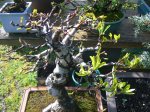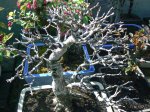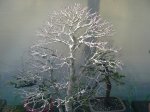Wiring deciduous species:
Decades ago I always removed all the wire from my deciduous bonsai before winter, and I have a lot of them to care for and am always creating new specimens. At that time we thought the wire would kill the delicate branches because of the cold.
When I was sponsoring symposia many years ago, I had a professor from Cornell University, who was my student, do some research on wire on deciduous species during the winter. Through actual research, what do you think he learned? He measured the temperature of the bark and discovered that the wire actually
INSULATED the bark! The bark temperature under the wire was warmer than branches which were unwired!!!
I wire, shape and transplant throughout the year, most species I rarely stop. I do this when I have the time, energy and am inspired. But, after care is very important. Usually I don't do too much shaping of winter hardy species during the dead of winter, because I hate the cold and stay indoors and work on the magazine or books or programs. But, if inspired, I'm out in the heated studio, often with my skilled and talented assistant Alan Adair, working on trees.
The actual best time to wire deciduous species is in the summer as the branches are maturing, not in spring as the buds are opening. But, like most people, I find it easier to wire those species without foliage before the expand. But, the wire must be carefully checked.
Bill
Here is a Koto Hime Japanese Maple I wired and shaped in early April while the leaves were opening. Please note this is training wiring, not exhibition wiring.
View attachment 160658 View attachment 160659


 2016-11-29_07-45-02
2016-11-29_07-45-02











